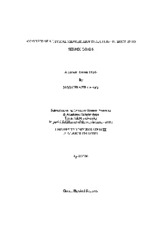| dc.creator | Hart, Jason Frazier | |
| dc.date.accessioned | 2013-02-22T20:40:49Z | |
| dc.date.available | 2013-02-22T20:40:49Z | |
| dc.date.created | 2000 | |
| dc.date.issued | 2013-02-22 | |
| dc.identifier.uri | https://hdl.handle.net/1969.1/ETD-TAMU-2000-Fellows-Thesis-H367 | |
| dc.description | Due to the character of the original source materials and the nature of batch digitization, quality control issues may be present in this document. Please report any quality issues you encounter to digital@library.tamu.edu, referencing the URI of the item. | en |
| dc.description | Includes bibliographical references (leaves 53-55). | en |
| dc.description.abstract | The extent of damage and casualties in Midwest cities such as St. Louis during an earthquake caused by the New Madrid fault system will be due in part to the performance of buildings. Dynamic nonlinear analysis of a reinforced concrete building not designed for seismic loads is one method used to assess an existing building's ability to withstand an earthquake. Many researchers have studied the earthquake resistance of structures, and often analytical studies have used recorded ground motions such as the 1940 El Centro, California, earthquake. Reports from past experimental studies and observations of damage caused by seismic events have been valuable for evaluating the performance of specific components of a building and overall performance of buildings subjected to this type of ground motion. This research study differs from previous research in that it focuses on the Midwest United States and uses synthetic ground motions developed specifically for an earthquake that would occur in this region. Research of the performance of a five-story, reinforced concrete, moment frame building in the Midwest United States is discussed in this thesis. In order to estimate the performance of a typical building in this region, the building was designed based on codes from the mid-1980's, prior to the seismic design standards of today requiring a ductile structural system. The study building's performance is evaluated using the dynamic nonlinear analysis computer program DRAIN-2DM. Dynamic analysis of the structure is performed using synthetic ground motions for the Midwest produced by Y.K. Wen of the Mid-America Earthquake Center. The analyses of the building were performed using twenty ground motion records. Ten ground motions are for earthquakes with two percent probabilities of exceedance in 50 years, and ten are for ten percent probabilities of exceedance in 50 years. Results of the analyses are discussed in this thesis and are used to estimate the damage to the structure. | en |
| dc.format.medium | electronic | en |
| dc.format.mimetype | application/pdf | |
| dc.language.iso | en_US | |
| dc.publisher | Texas A&M University | |
| dc.rights | This thesis was part of a retrospective digitization project authorized by the Texas A&M University Libraries in 2008. Copyright remains vested with the author(s). It is the user's responsibility to secure permission from the copyright holder(s) for re-use of the work beyond the provision of Fair Use. | en |
| dc.subject | physical sciences. | en |
| dc.subject | Major physical sciences. | en |
| dc.title | Analysis of a typical Midwestern structure subjected to seismic loads | en |
| thesis.degree.department | physical sciences | en |
| thesis.degree.discipline | physical sciences | en |
| thesis.degree.name | Fellows Thesis | en |
| thesis.degree.level | Undergraduate | en |
| dc.type.genre | thesis | en |
| dc.type.material | text | en |
| dc.format.digitalOrigin | reformatted digital | en |


